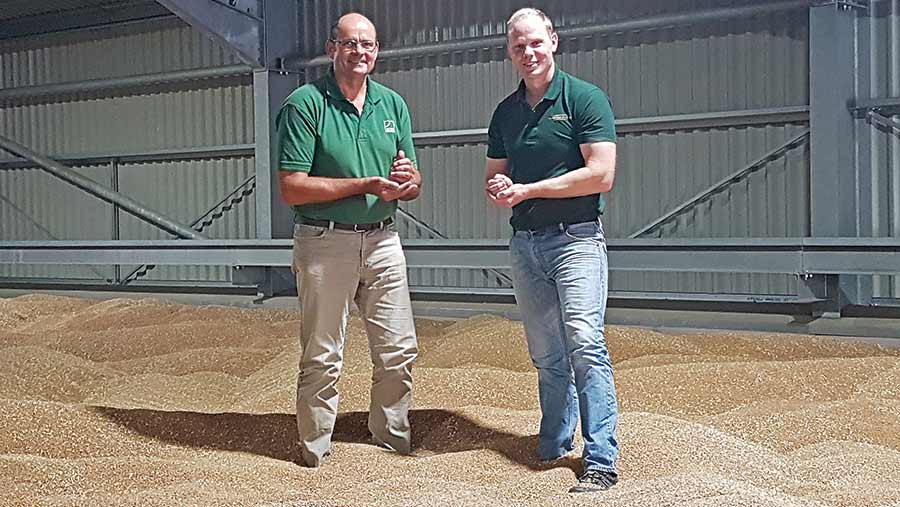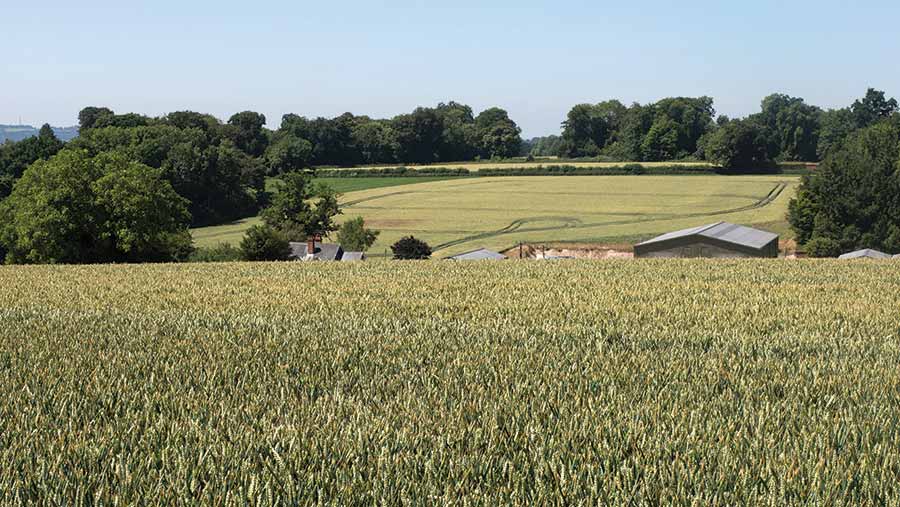Variable drilling lifts wheat yield by 1t/ha in Hampshire
 Richard Hales and Craig Livingstone © Lucinda Dann/RBI
Richard Hales and Craig Livingstone © Lucinda Dann/RBI Farm manager Craig Livingstone’s investment in mapping the highly variable soils on his Hampshire farm has paid off, after he hit his target yield for winter wheat this harvest despite the challenging season.
Mr Livingstone had hoped to push his average yield up to 10t/ha and beyond by matching his seed rates to his wildly contrasting chalk and clay soils.
And by varying his seed rate by as much as 25% between the different soil types, he achieved an average wheat yield of 10.53t/ha at Queenwood farm, at East Tytherley, nearly 1t/ha up on the farm’s average wheat yield.
Direct comparison
While all the winter wheat area was variably drilled last season, two fields with comparable soil were set aside so the effect of variably drilling could be assessed.
The two neighbouring fields – Closters, which was variably drilled, and Farm Hill, drilled at a flat rate – both straddle a clay bar and have both the lightest chalk and the heaviest clay soils.
Wheat variety Siskin was drilled using a Vaderstad Rapid 6m drill to achieve 280 plants/sq m across both fields, and plant counts taken in the autumn showed a much more even rate of establishment across the variably drilled field.
Shoot counts show this continued throughout the season. At the start of ear emergence, the difference in plant density on the clay and chalk areas was a maximum of 55 shoots/sq m.
Meanwhile, on the flat-rate field the difference was four times greater at 228 shoots/sq m, with the worst performing clay area measuring just 336 shoots/sq m.

© Hugh Nutt
Because of the better rate of establishment on the clay areas a yield of 11.6t/ha was recorded from Closters, while Farm Hill produced 11.2t/ha.
Mr Livingstone has calculated that if this 0.4t/ha yield uplift was achieved across the entire 95ha of wheat cut at Queenwood farm, this would equate to an additional 38t.
At his current average feed base price of £165/t, which has premiums still to add, this would mean an additional £6,270 added to the gross margin.
This of course does not take into account the other variables such as topography, depth to rock, shading and moisture, which also have an effect on yield.
“At that level of additional yield, that’s a good return on investment for us,” says Mr Livingstone. “At that rate we could comfortably be able to have the investment in soil mapping paid off within the four-year period.
Tweaks for next season
While he has already achieved the target set when he first started working with variable seed rate specialist Soyl to map the farm last year, there are still areas that can be improved on.
“I haven’t seen a yield like this at the farm in the three years since I’ve been here, so I think it will be fine-tuning rather than anything drastic for this coming season,” he says.
“Siskin doesn’t tiller as much as other varieties, so we are going to start with a slightly higher seed rate across both the clay and chalk, between 280-300.”
Richard Hales, area manager at Soyl, agreed, saying: “It’s about fine tuning the seed rate, and we can use the biomass imagery created by the mapping prior to combining, and also right through the main nitrogen season and do variable rate nitrogen.”
While Mr Livingstone believes seed rates hold the key to the biggest yield gains, the data produced through mapping the farm can also be used to do targeted slug pelleting.
“We do also have the potential to reduce cultivations here by not doing it all to the same depth or by the same amount,” he says.
“On the lighter chalk we could go straight in, but on the heavier clay it caps so we need to move it.
“We have done a bit more in the way of cultivation this year due to the weather, but we need to be a bit braver and leave it alone.”
Spring barley trial
Variably drilling the winter wheat area was the first stage to completely transitioning to variable drilling over three years on the farm.
Three-quarters of the 650ha arable cropping has been mapped ready for the upcoming season, including all of the spring crops.
This season 120ha of Propino spring barley and 40ha of Laureate will be drilled according to Soyl’s establishment map, but Mr Livingstone will also be conducting another trial on spring barley in order to remove the effect of winter kill.
He will be doing a split field trial in a 41ha field of Laureate as it spans the full range of different soil types.
By next season, Mr Livingstone plans to have everything variably drilled on the farm.
Ten tips for successful variable rate drilling
A third of winter wheat in the UK is drilled variably. Peter Croot, regional manager and seed specialist at Soyl, has some tips on how to get the most from variable-rate seeding.
- Establishment in heavier parts of fields will be worse than expected, often lower than 60%.
- Many fields will need a wide range of application rates for wheat – as wide as 100kg/ha.
- Where possible create variable-rate seed plans before ordering seed and then order based on what you need.
- If you have changed your drill make sure it is variable-rate compatible. Never assume a newer drill will have the same technology as the old drill.
- Don’t be afraid to tweak your variable rate maps as the season moves on. Most tools like mySOYL are web-based and allow adjustments for delayed drilling to be done in seconds.
- Don’t adjust just for soil type. Use weed maps and yield potential as other layers in your calculation.
- You don’t have to wait for your Thousand Grain Weight (TGW). Make your plans using a TGW of 50g and tweak them when the seed arrives.
- Delays in drilling need to be accounted for, but it is a simple adjustment to target rates. The range of establishment will work on a pro rata basis.
- It is the same decision-making process whether flat rate or variable. Seed rates need to consider conditions first.
- Think of your spring populations as a target. The variable plan in mySOYL accounts for germination, field loss and even adjusts for overlaps when using this option.

